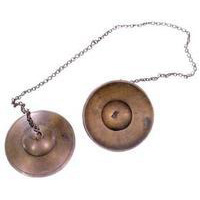pengzhong overview
 Peng cup (pinyin: Pèng zhōng), also known as ping bell, is a Mongolian percussion instrument. Popular in Inner Mongolia Autonomous Region. Made of copper, it is shaped like a small cymbal, with a diameter of 7.6 and a thickness of 0.6 cm. Consists of two sides. The middle of the cup surface is convex and hemispherical, and there is a small hole in the center of the ball, which can be set with a ring-tie copper chain, red silk, cloth belt, etc., to connect the two small cups together. Hit the sound with one hand on each side. The bump cup always hits with each eye, twice per eye.
Peng cup (pinyin: Pèng zhōng), also known as ping bell, is a Mongolian percussion instrument. Popular in Inner Mongolia Autonomous Region. Made of copper, it is shaped like a small cymbal, with a diameter of 7.6 and a thickness of 0.6 cm. Consists of two sides. The middle of the cup surface is convex and hemispherical, and there is a small hole in the center of the ball, which can be set with a ring-tie copper chain, red silk, cloth belt, etc., to connect the two small cups together. Hit the sound with one hand on each side. The bump cup always hits with each eye, twice per eye.The Dingxia used in Heijing Temple, Badi Township, Danba County, Ganzi Tibetan Autonomous Prefecture, Sichuan Province, is slightly larger, with a diameter of 9 cm and a height of 3 cm. Inner Mongolia Lama Monastery has the largest cup, with a mouth diameter of 12 cm and a height of 2 cm. The base of the bowl and the edge of the cup are each cast with a ring of raised stripes. The top of the bowl is drilled and tied with silk cloth, leather strips or copper rings, and two pieces are a pair. The two cups are connected by a leather rope or copper chain woven with thin leather strips.
When playing, hold a cup in each hand, hold the wider part of the leather strip on the top of the cup, raise the mouth of the cup up in front of the chest, and hit the sides of the cup with each other to pronounce. Some monasteries only use one cup, hold the cup in the left hand, hold the cup in the right hand, and tap the side of the cup to pronounce. The tone is clear and crisp, with strong penetrating power and continuous sound length. It is used in religious rituals, Buddhist monastery chanting, Taoist cave scripture music and folk song and dance accompaniment.
- Pinyin:Pèng zhōng
- material:copper
- nickname:ring the bell
- type:Mongolian percussion instrument
reference materials and contributors
- 碰盅 · 百度百科
- 碰盅 · 搜狗百科
- 藏传密宗老天铁小镲法器碰盅碰铃法器佛教用品收藏品古董古玩包老 · 中华古玩网
overview of other similar instruments
- sanyanxiao overview
- Daguangxian overview
- Leiqin overview
- hahao overview
- yandundagu overview
- Han Xiaozheng overview
- Fang Xiang overview
- guanzi overview
- zhuqin (Dao Qin) overview
- zhuiqin overview
- bangzi overview
- three-stringed piano overview
- Gehu overview
- xiao overview
- xiaokonghou overview
- Konghou overview
- Sheng overview
- suona overview
- hulusi overview
- gushao overview
 渝公网安备 50010702504639号
渝公网安备 50010702504639号